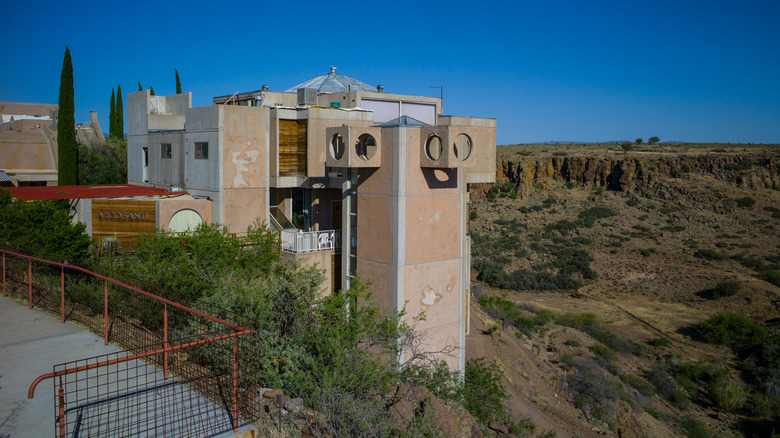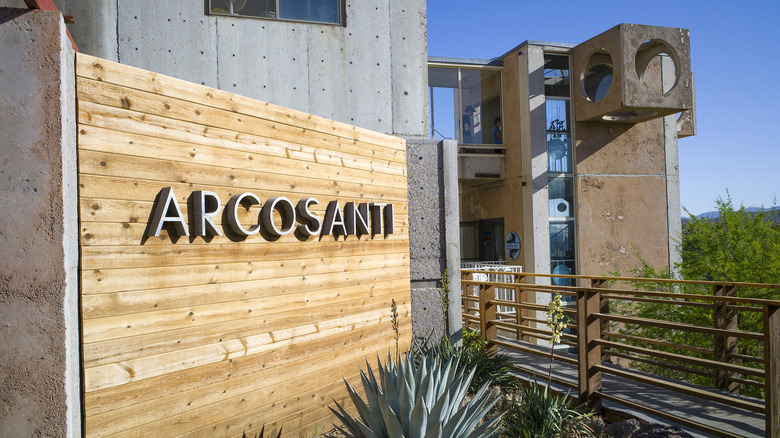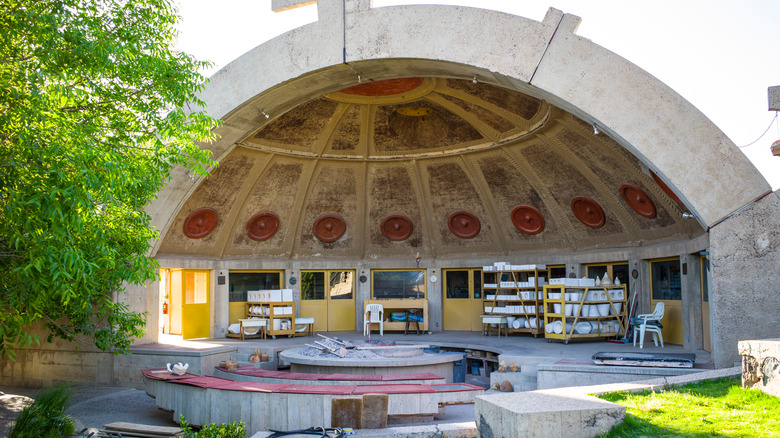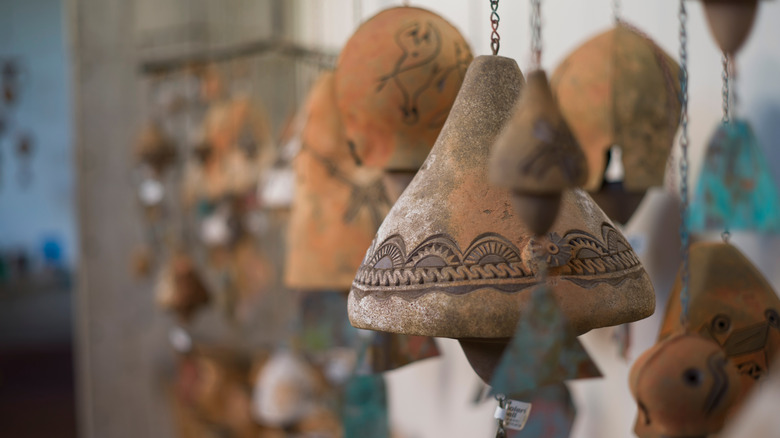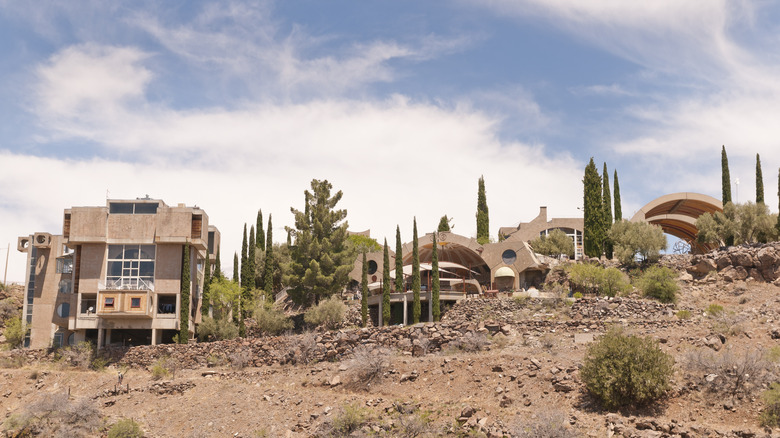Arizona's 'City Of The Future' Is An Odd Experimental Desert Town With Unique Architecture
At an exit off I-17, about halfway between the Arizona cities of Phoenix and Sedona, you'll come upon an experimental desert town that looks like something out of a '70s sci-fi movie. Welcome to Arcosanti, the esoteric brainchild of a deceased architect with a penchant for portmanteaus. It was constructed (or cobbled together) by thousands of volunteers under the auspices of the Cosanti Foundation, which combines "cosa," the Italian word for "things," with "anti" to signify that it's against consumerism. The nonprofit foundation calls Arcosanti "the world's first prototype arcology." That, too, is a portmanteau, symbolizing a new kind of fusion between architecture and ecology.
Arcologies are meant to be mega-cities, seamlessly integrated into the natural environment. Left unfinished in the Sonoran Desert, Arcosanti has never risen above the level of a micro-city. People live and work here, but no more than 100 at any given time, per the foundation. The main industry is wind bells, bronzed under a semicircular foundry apse where "geometric shapes and organic motifs" reflect the town as a whole. It's a place with sky and sun suites and greenhouse guest rooms, overlooking high desert mesas and the Agua Fria River canyon — topographical features that collectively form a national monument. Blocks with circular windows jut from the top of one weather-beaten building, recalling Tokyo's demolished Nakagin Capsule Tower, a metabolist, mixed-use structure that began construction around the same time in 1970.
Architectural Digest describes Arcosanti as a "city of the future that time forgot." Another word for that would be retro-futuristic. That's a box Arcosanti definitely ticks, though it wasn't necessarily the intent when building first got underway all those years ago.
Tours of Arcosanti, overnight stays, and Form Festival
Arcosanti's visitor center, café, wind bell gallery, and gift shop are public areas, but tourists are not allowed to waltz in on self-guided tours. The only way for non-guests to explore most of the town's surreal, ramshackle architecture is by taking a resident-led guided tour, which requires signing a consent and release form to absolve the Cosanti Foundation of any liability in the event you're injured. Tomiaki Tamura, a longtime assistant to the city's designer, leads the 90-minute architectural tour every other Saturday. There's also a regular daily tour, plus appointment-only tours of Arcosanti's archives and sustainability features.
If you spend the night in a guest room or suite, you'll have the run of the place in a way you otherwise wouldn't — even on a tour. Guests are given free run of the grounds, including the pool. Walking around, you can see firsthand how Arcosanti was designed to be compact and "build up, not out," remaining car-free to counteract urban sprawl. Residents share a trading post, Ferguson's, a free "emporium of take what you need, leave what you don't," as one maintenance and construction volunteer called it on Facebook.
Another way to visit Arcosanti is as a concertgoer. It serves as the venue for Form Festival, which sold out in 2024 as it celebrated its 10th anniversary with a lineup including Beck and Skrillex. Artists perform in Arcosanti's amphitheater and ceramic apse and under its open-air vaults, bringing attendees right into the heart of the arcology. The festival also provides a more readable map of Arcosanti than the black-and-white one on the consent and release form.
Where Star Wars meets Mad Max
According to National Geographic, "Star Wars" creator George Lucas once scouted Arcosanti, taking inspiration from its domed rooftops before he brought the desert planet Tatooine to life for the first movie in 1977. It has the grungy, lived-in quality of the homestead where Luke Skywalker grew up and the spaceport where he boarded that "piece of junk" ship, the Millennium Falcon, for the stars. However, it was places in Tunisia, like the Hotel Sidi Driss, where the actual filming of those "Star Wars" locations took place. This has left Arcosanti with more of an apocryphal connection to the galaxy far, far away.
The place does have a third-floor Sky Suite, and you might need to walk up some stairs to reach it (since there are no elevators). Other than that, you might feel less like Luke Skywalker and more like Mad Max when you stay here. One Tripadvisor reviewer says Arcosanti reminded them of "something from a post apocalyptic movie," such as "Mad Max: Beyond Thunderdome." Another says it reminded them of "an abandoned hotel in Mexico," adding, "If this is the city of the future, it's a bleak dystopian one."
Even a writer for The Los Angeles Times mentions chipped paint and "a cracked bathroom mirror and cobwebs" in their guest room at Arcosanti. Though it mostly eschews a theme park's kitsch and commerce (except for that gift shop with the wind bells that cost hundreds), the town somewhat recalls Walt Disney's original plan for EPCOT as an "Experimental Prototype Community of Tomorrow." As you learn more about its history, it becomes clear that this is a failed utopia.
Paolo Soleri World
The elephant in the room with Arcosanti is Paolo Soleri, the late architect behind the arcology concept. In this desert EPCOT, he's the Walt Disney figure, an innovator who inspired a hagiographic devotion in his acolytes and the media. Born in Turin, Italy, Soleri immigrated to Arizona in 1947, where he trained under renowned architect Frank Lloyd Wright at his desert laboratory, Taliesin West. In the 1950s, a dome house Soleri built in Cave Creek helped him make a name for himself before he settled in Paradise Valley. The latter town still holds his design studio — Cosanti — but it's now a Phoenix suburb, having been swallowed up by the same urban sprawl his architecture sought to subvert.
The visuals and countercultural ideas in Soleri's 1969 book, "Arcology: The City in the Image of Man," became the blueprint for Arcosanti. If this is Soleri World, there's no immediate mention of him on its home page. It hasn't entirely scrubbed his name from its history, but there's a reason it may not want to advertise him too outwardly.
In 2017, Soleri became one of the early public figures implicated in the #MeToo movement when his daughter, Daniela Soleri, published a Medium essay alleging that he sexually abused her. Stories of his unwelcome advances toward nude models soon emerged, with Daniela telling The Guardian in 2020, "This has been going on for a long time, and the people in what I call his inner circle, they knew about it." With his reputation in tatters, Paolo Soleri began to posthumously resemble more of a patriarchal, hippie cult leader, surrounded by disciples in a doomed desert commune.
'The City in the Image of Man'
The myth of Arcosanti has survived 50-plus years even as the town has fallen into a state of disrepair. Soleri envisioned it as a self-sustaining community with moving walkways and a population of thousands, but only 20% of his architectural plans were ever realized. Residents also defy the car-free ethos with regular supply runs to budget-friendly Phoenix. Per The Guardian, Tomiaka Tamura, the assistant-turned-tour-guide, now qualifies his lectures by saying there was "a side of Soleri that was not very good." The same could be said of Arcosanti, where past Sky Suite guests have complained of design fails like dangerous steps and a shower that drains into the bedroom.
As the prototypical arcopolis, Soleri's "City in the Image of Man" wound up being deeply flawed and all too human in how its reach exceeded its grasp. Nonetheless, the pull of curious architecture still brings tourists here on road trips to the Grand Canyon. With castles and churches built into limestone cliffs and red rock buttes, the road from Phoenix to Sedona could be considered Arizona's architectural drive of fame.
In the Phoenix area, you can take a tour of Cosanti and Taliesin West. After Arcosanti, you'll hit Montezuma Castle National Monument (in Camp Verde) and the Chapel of the Holy Cross (in the hiker's paradise of Sedona). These landmarks all endure as architectural feats, but the unfinished nature of Arcosanti lends it a gloomier, more enigmatic quality. Like potent ideas bubbling up out of the desert, its curved structural patterns stand as a testament to both ingenuity and corruption, the kind that can only seep in from the duality of human nature.
